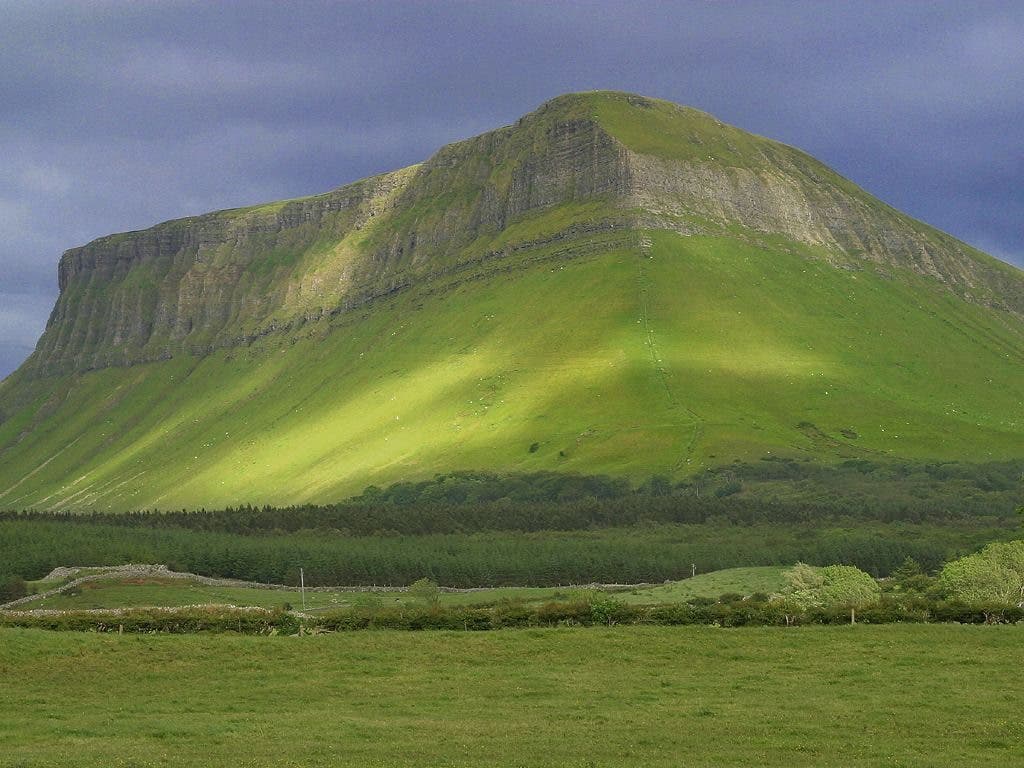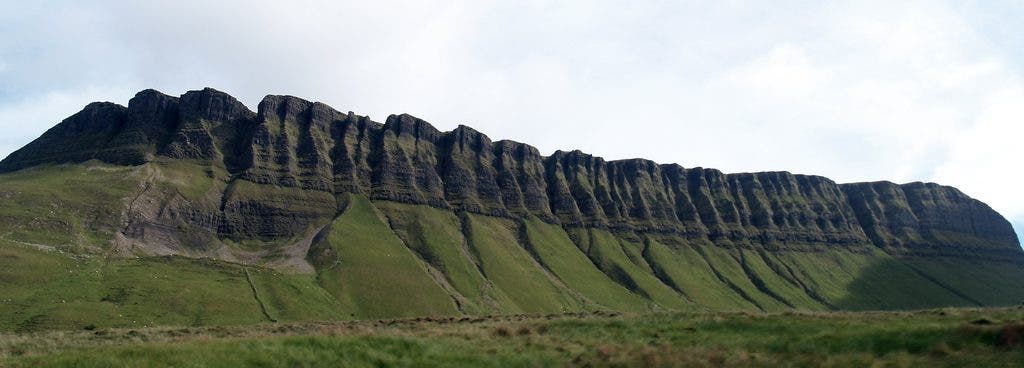Rising dramatically above the landscape of County Sligo, Benbulbin is one of Ireland’s most distinctive landmarks. Its flat summit, steep cliffs, and unusual shape have made it a major touristic attraction — and also an area of geologic interest. Beneath its striking exterior lies a rich geological story that spans millions of years—a tale shaped by tectonic forces, corals, glaciers, and the slow, persistent work of erosion.

Benbulbin is part of the Dartry Mountain range and stands 526 meters (1,726 feet). Its formation began over 300 million years ago in a period called the Carboniferous. The period is called the Carboniferous because of the vast amounts of carbon-rich coal deposits formed during this time.
At that time, what is now Ireland was submerged under a shallow tropical sea. The marine environment was home to a wide variety of marine life, including corals, shellfish, and ancient fish species. Herein starts the geological tale of Benbulbin.
As these organisms lived and died, their skeletons and shells accumulated on the seafloor, eventually compacting into layers of limestone, which would later become one of the key components of Benbulbin’s geology. Today, this limestone forms the lower slopes of the mountain, and it’s filled with fossils that offer a window into a world that existed hundreds of millions of years ago.
above the limestone lies a layer of shale, a sedimentary rock formed from clay and silt. Shale’s darker color contrasts with the pale limestone below and marks a period of significant environmental change. The presence of shale indicates that the once-tropical sea had begun to retreat, leaving behind swampy environments where rivers deposited fine sediments.
But why is it shaped like a table?
All that is fine and cool but what truly sets Benbulbin apart is its unique flat-topped appearance, reminiscent of a table mountain. To understand how this shape came to be, we need to fast forward to the forces that shaped Ireland during the last Ice Age, around 10,000 years ago.
During this period, Ireland (like much of Europe) was covered in massive glaciers that slowly carved their way through the landscape. These glaciers were powerful enough to reshape entire mountains, and Benbulbin was no exception. The ice sheets moved from northeast to southwest, scouring the earth and leaving behind dramatic cliffs and steep slopes.
As the glaciers moved, they eroded the softer layers of shale and limestone, while the harder rock above resisted erosion. This difference in erosion rates is responsible for Benbulbin’s stepped appearance, where the lower slopes are gently sloping, but the upper cliffs are nearly vertical. The mountain’s distinctive shape owes much to this glacial activity, which left behind the sharp ridges and flat summit that have become so iconic.

The Role of Tectonics
While glaciers and erosion played significant roles in shaping Benbulbin, it’s tectonic forces that set the stage for everything to happen. Around 400 million years ago, during the Devonian period, the landmass that would eventually become Ireland was part of a supercontinent called Pangea, located near the equator. The collision of tectonic plates caused intense folding and faulting in the earth’s crust, which raised the land above sea level and created mountain ranges.
As tectonic forces continued to act on the region, the landscape was slowly transformed. Volcanic activity and uplift contributed to the formation of the limestone and shale layers that now make up Benbulbin. Over time, these tectonic forces would also play a role in shaping the broader landscape of County Sligo, with Benbulbin standing as one of the most visible reminders of this geological activity.
The mountain is still changing
Benbulbin’s current appearance is the result of millions of years of natural processes, but the landscape around the mountain is still changing today. Erosion continues to shape the cliffs and ridges, slowly wearing away at the rock and altering the mountain’s profile. This process is slow, almost imperceptible to human eyes, but over the course of millennia, it will continue to reshape the landscape.
Landslides are not uncommon in the area, particularly after heavy rains, when water seeps into cracks in the rock and loosens large sections of the cliffs. These processes are a reminder that, while Benbulbin may seem like a permanent fixture in the landscape, it is still subject to the forces of nature.
Who knows what it will look like millions of years from now?










